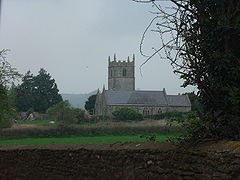Stanton Drew
| Stanton Drew | |
|---|---|
 St Mary the Virgin Church at Stanton Drew |
|
| Stanton Drew shown within Somerset | |
| Population | 787 (2011) |
| OS grid reference | ST597632 |
| Unitary authority | |
| Ceremonial county | |
| Region | |
| Country | England |
| Sovereign state | United Kingdom |
| Post town | BRISTOL |
| Postcode district | BS39 4 |
| Dialling code | 01275 |
| Police | Avon and Somerset |
| Fire | Avon |
| Ambulance | South Western |
| EU Parliament | South West England |
| UK Parliament | |
Stanton Drew is a small village and civil parish within the Chew Valley in Somerset, England, situated north of the Mendip Hills, 8 miles (12.9 km) south of Bristol in the Bath and North East Somerset Unitary Authority.
The village is most famous for its prehistoric Stanton Drew stone circles, the largest being the Great Circle, a henge monument consisting of the second largest stone circle in Britain (after Avebury). The stone circle is 113 m in diameter and probably consisted of 30 stones, of which 27 survive today.
The village also has a range of listed buildings, dating from the 13th to 15th centuries, including the church of St Mary the Virgin, the Round House (Old Toll House) and various farmhouses.
The parish of Stanton Drew, which includes the hamlet of Stanton Wick has a population of 787. It includes a primary school, pub (the Druids Arms), church and village hall, which is the venue for a mother and toddler group and preschool as well as various village activities. The area around the village has several dairy and arable farms on neutral to acid red loamy soils with slowly permeable subsoils. It is also a dormitory village for people working in Bath and Bristol.
Stanton Drew was listed in the Domesday Book of 1086 as Stantone, meaning 'The stone enclosure with an oak tree' from the Old English stan and tun and from the Celtic deru.
After the Norman Conquest the Lords of the Manor took their name from the village. In the reign of Henry II Robert de Stanton was succeeded by Geoffrey de Stanton. One of the family Drogo or Drew gave his name to the place to distinguish it from Stanton Prior and Stanton Wick. It subsequently came into the possession of the Choke and then the Cooper and Coates families.
...
Wikipedia

